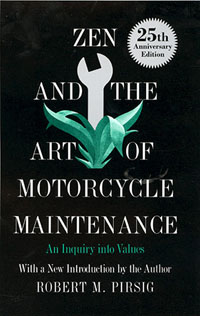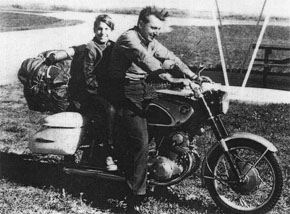| Zen
and the Art of Motorcycle Maintenance
By
Robert M Pirsig
 And
what is good Phaedrus? And
what is good Phaedrus?
And what is not good?
Need we ask anyone to tell us these things?
‘Zen
and the Art of Motorcycle Maintenance,’ was to become one
of most influential novels of the 70’s. It became something
of a cult book amongst the beat generation when it was published
in 1974.Previously turned down by over 121 publishers it has since
sold over well 5million copies. That it was rejected by so many
publishers is not so hard to understand as it is a densely argued
philosophical investigation of values as its sub title suggests.
The book is almost impossible to characterize but. perhaps the closest
to it is Hermann Hesse's ‘The Glass Bead Game’, or ‘Steppenwolf,’
but ‘On the Road,’ by Jack Kerouac covers some of the
same territory.The title is a not so subtle allusion to the ‘Zen
in the Art of Archery,’ by Eugen Herrigel. This German philosopher
had trained for six years in Japan in 1930s learning the chivalrous
art of archery from a Zen master. But in the introduction to his
book, Pirsig explains that, despite its title, "it should in
no way be associated with that great body of factual information
relating to orthodox Zen Buddhist practice. It's not very factual
on motorcycles either.”
The book describes a 17-day journey motorcycle journey from Minnesota
to California by the author and his son Chris and a couple who are
close friends. This journey is punctuated by numerous philosophical
discussions tied together by the story of the narrator's own past
self, who is referred as ‘Phaedrus,’ one of the figures
in Plato’s dialogues. Phaedrus is a teacher of creative and
technical writing at a small college who had become engrossed in
the question of what defines ‘good,’ writing, and what,
in general, defines our views of what is good or quality. How we
decide this is central to the discussion on the journey and also
how we know the difference. Two potential ways we look at the world,
here termed the Classical and the Romantic, are examined .The Classical
divides the motorcycle (for instance) into its components. The Romantic
only sees the complete and finished motorcycle. These two ways of
looking at reality are both typical of humans, but are entirely
incompatible.
As the story and the discourse unfold on different levels, we discover
that 'Phaedrus' became obsessed with the idea of reconciling these
two sets of values - a quest that took him deep into philosophy
and eventually to such strange paths that he stepped outside the
'Church of Reason' and was considered insane. After treatment in
a mental institution, his ‘Phaedrus,’ personality was
removed, leaving him with only the relics of what he used to be
and know, like archaeological ruins in a field. The journey, on
a third level, is not only to rediscover Phaedrus but also to piece
together from these 'ruins' the conclusions he came to. Finally
he presents us with an entirely new 'third' way of looking at reality.
He aims towards a perception of the world that embraces both sides
the rational and the romantic. This means encompassing "irrational"
sources of wisdom and understanding. In particular, this must include
bursts of creativity and intuition that seemingly come from nowhere
and are not (in his view) rationally explicable. Phaedrus seeks
to demonstrate that rationality and a Zen-like "being in the
moment" can harmoniously coexist and suggests that such a combination
of rationality and romanticism, a new middle way, can potentially
bring a higher quality of life

Whether
you accept his conclusions or not this book is a brilliant achievement
- sad, funny, wise, moving, uplifting, enlightening - it works on
many different levels and lingers in the mind over the years. Definitely
a fine thought provoking read if you have a philosophical turn of
mind or are interested in finding your own third way.
Michael
Kogan Muju
Radiant Light Vow No Abode Dwelling
Back
to front page
|
 And
what is good Phaedrus?
And
what is good Phaedrus?